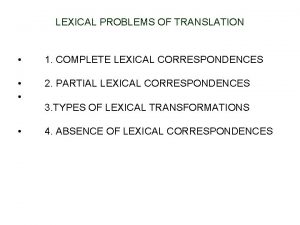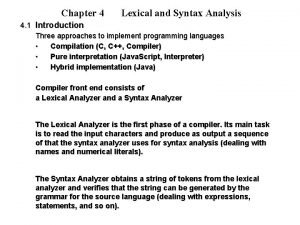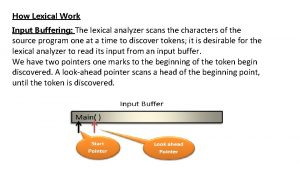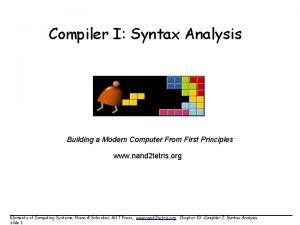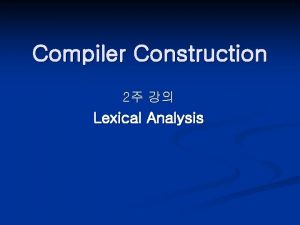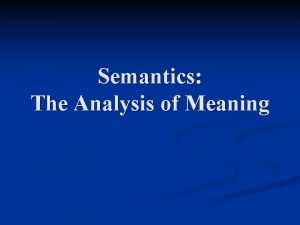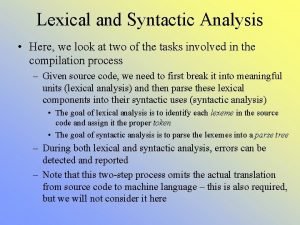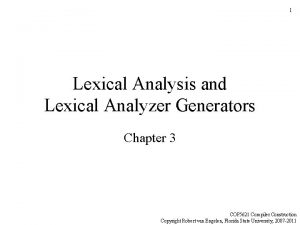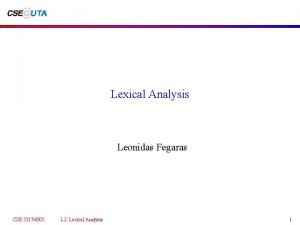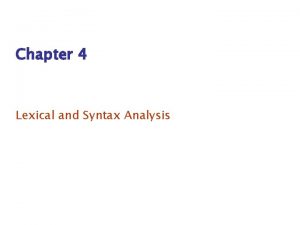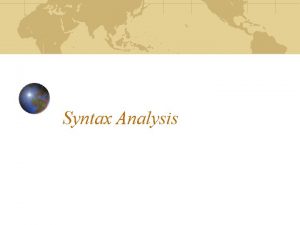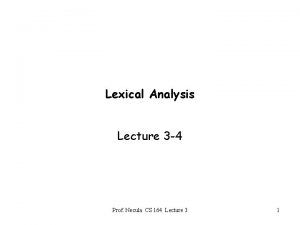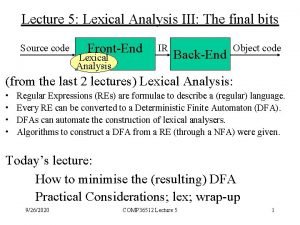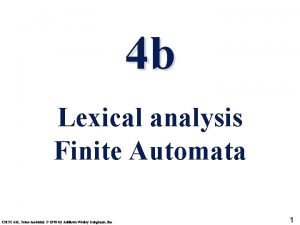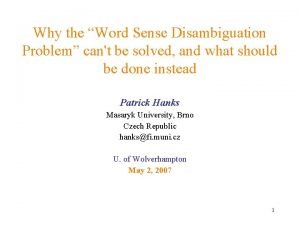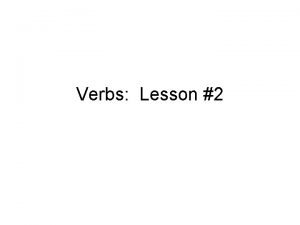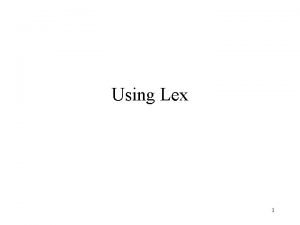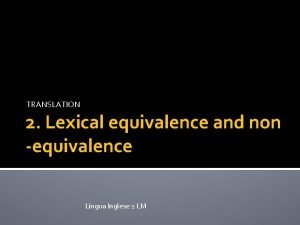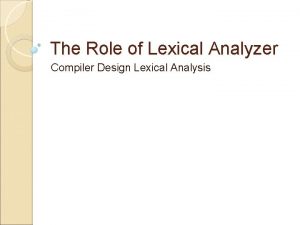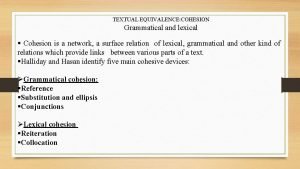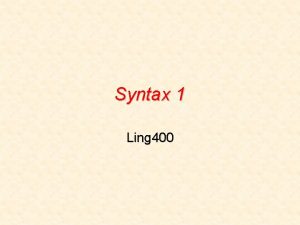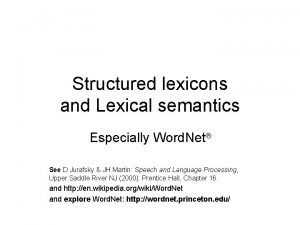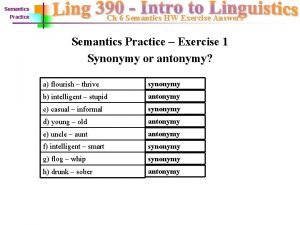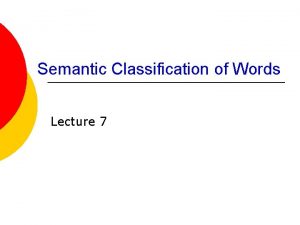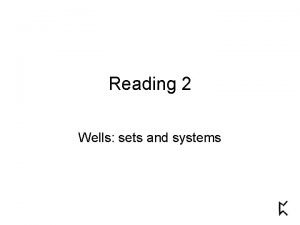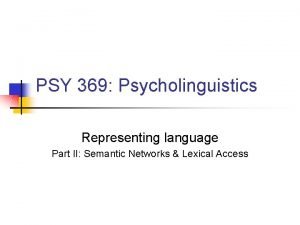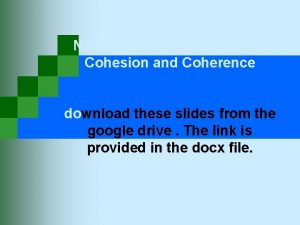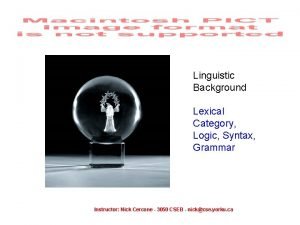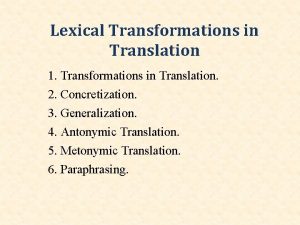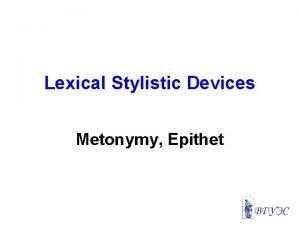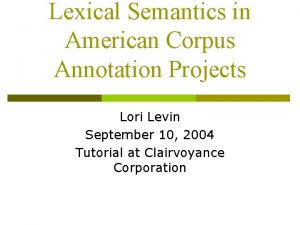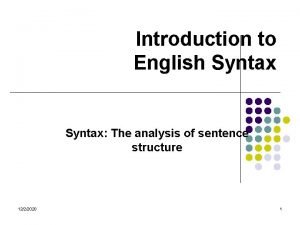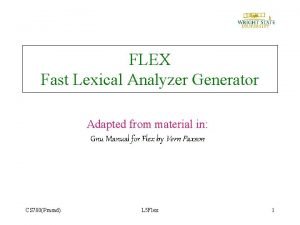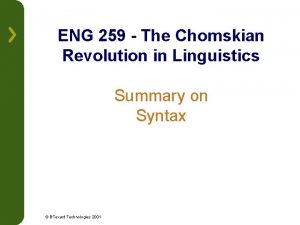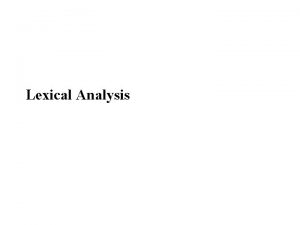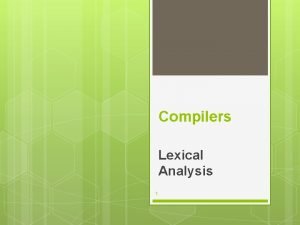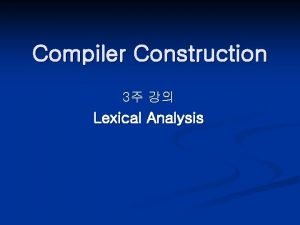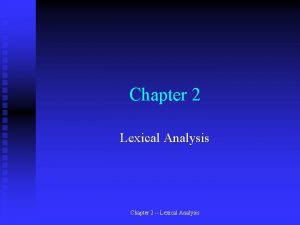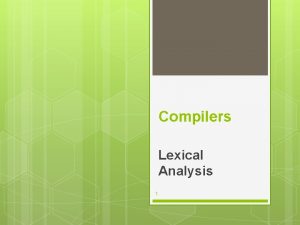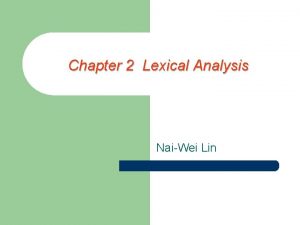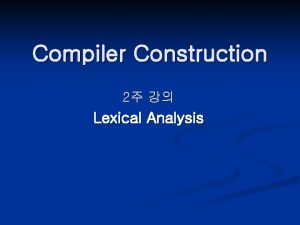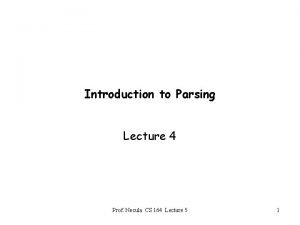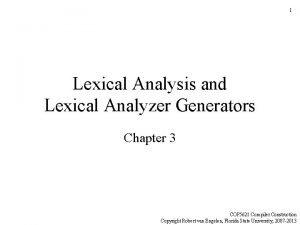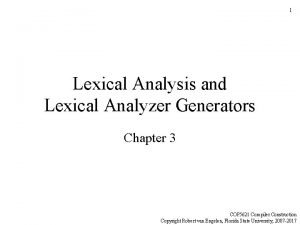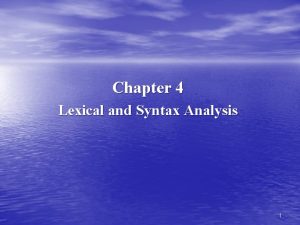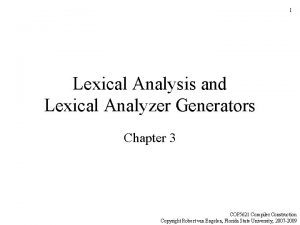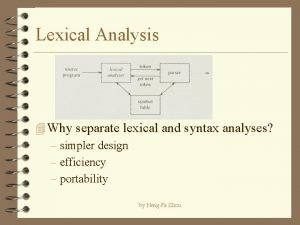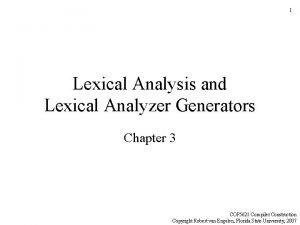Lexical Analysis Lecture 3 4 Prof Necula CS






























































- Slides: 62

Lexical Analysis Lecture 3 -4 Prof. Necula CS 164 Lecture 3 1

Course Administration • PA 1 due September 16 11: 59 PM • Read Chapters 1 -3 of Red Dragon Book • Continue Learning about Flex or JLex Prof. Necula CS 164 Lecture 3 2

Outline • Informal sketch of lexical analysis – Identifies tokens in input string • Issues in lexical analysis – Lookahead – Ambiguities • Specifying lexers – Regular expressions – Examples of regular expressions Prof. Necula CS 164 Lecture 3 3

Recall: The Structure of a Compiler Source Lexical analysis Today we start Optimization Tokens Parsing Interm. Language Prof. Necula CS 164 Lecture 3 Code Gen. Machine Code 4

Lexical Analysis • What do we want to do? Example: if (i == j) z = 0; else z = 1; • The input is just a sequence of characters: tif (i == j)nttz = 0; ntelsenttz = 1; • Goal: Partition input string into substrings – And classify them according to their role Prof. Necula CS 164 Lecture 3 5

What’s a Token? • Output of lexical analysis is a stream of tokens • A token is a syntactic category – In English: noun, verb, adjective, … – In a programming language: Identifier, Integer, Keyword, Whitespace, … • Parser relies on the token distinctions: – E. g. , identifiers are treated differently than keywords Prof. Necula CS 164 Lecture 3 6

Tokens • Tokens correspond to sets of strings. • Identifier: strings of letters or digits, starting with a letter • Integer: a non-empty string of digits • Keyword: “else” or “if” or “begin” or … • Whitespace: a non-empty sequence of blanks, newlines, and tabs • Open. Par: a left-parenthesis Prof. Necula CS 164 Lecture 3 7

Lexical Analyzer: Implementation • An implementation must do two things: 1. Recognize substrings corresponding to tokens 2. Return the value or lexeme of the token – The lexeme is the substring Prof. Necula CS 164 Lecture 3 8

Example • Recall: tif (i == j)nttz = 0; ntelsenttz = 1; • Token-lexeme pairs returned by the lexer: – – – – (Whitespace, “t”) (Keyword, “if”) (Open. Par, “(“) (Identifier, “i”) (Relation, “==“) (Identifier, “j”) Prof. Necula CS 164 Lecture 3 … 9

Lexical Analyzer: Implementation • The lexer usually discards “uninteresting” tokens that don’t contribute to parsing. • Examples: Whitespace, Comments • Question: What happens if we remove all whitespace and all comments prior to lexing? Prof. Necula CS 164 Lecture 3 10

Lookahead. • Two important points: 1. The goal is to partition the string. This is implemented by reading left-to-right, recognizing one token at a time 2. “Lookahead” may be required to decide where one token ends and the next token begins – Even our simple example has lookahead issues i vs. if = vs. == Prof. Necula CS 164 Lecture 3 11

Next • We need – A way to describe the lexemes of each token – A way to resolve ambiguities • Is if two variables i and f? • Is == two equal signs = =? Prof. Necula CS 164 Lecture 3 12

Regular Languages • There are several formalisms for specifying tokens • Regular languages are the most popular – Simple and useful theory – Easy to understand – Efficient implementations Prof. Necula CS 164 Lecture 3 13

Languages Def. Let S be a set of characters. A language over S is a set of strings of characters drawn from S ( is called the alphabet ) Prof. Necula CS 164 Lecture 3 14

Examples of Languages • Alphabet = English characters • Language = English sentences • Alphabet = ASCII • Language = C programs • Not every string on English characters is an English sentence • Note: ASCII character set is different from English character set Prof. Necula CS 164 Lecture 3 15

Notation • Languages are sets of strings. • Need some notation for specifying which sets we want • For lexical analysis we care about regular languages, which can be described using regular expressions. Prof. Necula CS 164 Lecture 3 16

Regular Expressions and Regular Languages • Each regular expression is a notation for a regular language (a set of words) • If A is a regular expression then we write L(A) to refer to the language denoted by A Prof. Necula CS 164 Lecture 3 17

Atomic Regular Expressions • Single character: ‘c’ L(‘c’) = { “c” } (for any c 2 ) • Concatenation: AB (where A and B are reg. exp. ) L(AB) = { ab | a 2 L(A) and b 2 L(B) } • Example: L(‘i’ ‘f’) = { “if” } (we will abbreviate ‘i’ ‘f’ as ‘if’ ) Prof. Necula CS 164 Lecture 3 18

Compound Regular Expressions • Union L(A | B) = { s | s 2 L(A) or s 2 L(B) } • Examples: ‘if’ | ‘then‘ | ‘else’ = { “if”, “then”, “else”} ‘ 0’ | ‘ 1’ | … | ‘ 9’ = { “ 0”, “ 1”, …, “ 9” } (note the … are just an abbreviation) • Another example: (‘ 0’ | ‘ 1’) = { “ 00”, “ 01”, “ 10”, “ 11” } Prof. Necula CS 164 Lecture 3 19

More Compound Regular Expressions • So far we do not have a notation for infinite languages • Iteration: A* L(A*) = { “” } [ L(A) [ L(AAA) [ … • Examples: ‘ 0’* = { “”, “ 00”, “ 000”, …} ‘ 1’ ‘ 0’* = { strings starting with 1 and followed by 0’s } • Epsilon: L( ) = { “” } Prof. Necula CS 164 Lecture 3 20

Example: Keyword – Keyword: “else” or “if” or “begin” or … ‘else’ | ‘if’ | ‘begin’ | … (Recall: ‘else’ abbreviates ‘e’ ‘l’ ‘s’ ‘e’ ) Prof. Necula CS 164 Lecture 3 21

Example: Integers Integer: a non-empty string of digits digit = ‘ 0’ | ‘ 1’ | ‘ 2’ | ‘ 3’ | ‘ 4’ | ‘ 5’ | ‘ 6’ | ‘ 7’ | ‘ 8’ | ‘ 9’ number = digit* Abbreviation: A+ = A A* Prof. Necula CS 164 Lecture 3 22

Example: Identifier: strings of letters or digits, starting with a letter = ‘A’ | … | ‘Z’ | ‘a’ | … | ‘z’ identifier = letter (letter | digit) * Is (letter* | digit*) the same ? Prof. Necula CS 164 Lecture 3 23

Example: Whitespace: a non-empty sequence of blanks, newlines, and tabs (‘ ‘ | ‘t’ | ‘n’)+ (Can you spot a small mistake? ) Prof. Necula CS 164 Lecture 3 24

Example: Phone Numbers • Regular expressions are all around you! • Consider (510) 643 -1481 = { 0, 1, 2, 3, …, 9, (, ), - } area = digit 3 exchange = digit 3 phone = digit 4 number = ‘(‘ area ‘)’ exchange ‘-’ phone Prof. Necula CS 164 Lecture 3 25

Example: Email Addresses • Consider necula@cs. berkeley. edu = letter | ‘. ’ | ‘@’ } name = letter+ address = name ‘@’ name (‘. ’ name)* Prof. Necula CS 164 Lecture 3 26

Summary • Regular expressions describe many useful languages • Next: Given a string s and a rexp R, is • But a yes/no answer is not enough ! • Instead: partition the input into lexemes • We will adapt regular expressions to this goal Prof. Necula CS 164 Lecture 3 27

Outline • Specifying lexical structure using regular expressions • Finite automata – Deterministic Finite Automata (DFAs) – Non-deterministic Finite Automata (NFAs) • Implementation of regular expressions Reg. Exp => NFA => DFA => Tables Prof. Necula CS 164 Lecture 3 28

Regular Expressions => Lexical Spec. (1) 1. Select a set of tokens • Number, Keyword, Identifier, . . . 2. Write a R. E. for the lexemes of each token • • • Number = digit+ Keyword = ‘if’ | ‘else’ | … Identifier = letter (letter | digit)* Open. Par = ‘(‘ … Prof. Necula CS 164 Lecture 3 29

Regular Expressions => Lexical Spec. (2) 3. Construct R, matching all lexemes for all tokens R = Keyword | Identifier | Number | … = R 1 | R 2 | R 3 |… Facts: If s L(R) then s is a lexeme – – Furthermore s L(Ri) for some “i” This “i” determines the token that is reported Prof. Necula CS 164 Lecture 3 30

Regular Expressions => Lexical Spec. (3) 4. Let the input be x 1…xn • (x 1. . . xn are characters in the language alphabet) For 1 i n check x 1…xi L(R) ? 5. It must be that x 1…xi L(Rj) for some i and j 6. Remove x 1…xi from input and go to (4) Prof. Necula CS 164 Lecture 3 31

Lexing Example R = Whitespace | Integer | Identifier | ‘+’ • Parse “f +3 +g” – – “f” matches R, more precisely Identifier “+“ matches R, more precisely ‘+’ … The token-lexeme pairs are (Identifier, “f”), (‘+’, “+”), (Integer, “ 3”) (Whitespace, “ “), (‘+’, “+”), (Identifier, “g”) • We would like to drop the Whitespace tokens – after matching Whitespace, continue matching Prof. Necula CS 164 Lecture 3 32

Ambiguities (1) • There ambiguities in the algorithm • Example: R = Whitespace | Integer | Identifier | ‘+’ • Parse “foo+3” – “f” matches R, more precisely Identifier – But also “fo” matches R, and “foo”, but not “foo+” • How much input is used? What if • x 1…xi L(R) and also x 1…x. K L(R) – “Maximal munch” rule: Pick the longest possible substring that matches R Prof. Necula CS 164 Lecture 3 33

More Ambiguities R = Whitespace | ‘new’ | Integer | Identifier • Parse “new foo” – “new” matches R, more precisely ‘new’ – but also Identifier, which one do we pick? • In general, if x 1…xi L(Rj) and x 1…xi L(Rk) – Rule: use rule listed first (j if j < k) • We must list ‘new’ before Identifier Prof. Necula CS 164 Lecture 3 34

Error Handling R = Whitespace | Integer | Identifier | ‘+’ • Parse “=56” – No prefix matches R: not “=“, nor “=5”, nor “=56” • Problem: Can’t just get stuck … • Solution: – Add a rule matching all “bad” strings; and put it last • Lexer tools allow the writing of: R = R 1 |. . . | Rn | Error – Token Error matches if nothing else matches Prof. Necula CS 164 Lecture 3 35

Summary • Regular expressions provide a concise notation for string patterns • Use in lexical analysis requires small extensions – To resolve ambiguities – To handle errors • Good algorithms known (next) – Require only single pass over the input – Few operations per character (table lookup) Prof. Necula CS 164 Lecture 3 36

Finite Automata • Regular expressions = specification • Finite automata = implementation • A finite automaton consists of – – – An input alphabet A set of states S A start state n A set of accepting states F S A set of transitions state input state Prof. Necula CS 164 Lecture 3 37

Finite Automata • Transition s 1 a s 2 • Is read In state s 1 on input “a” go to state s 2 • If end of input (or no transition possible) – If in accepting state => accept – Otherwise => reject Prof. Necula CS 164 Lecture 3 38

Finite Automata State Graphs • A state • The start state • An accepting state • A transition a Prof. Necula CS 164 Lecture 3 39

A Simple Example • A finite automaton that accepts only “ 1” 1 • A finite automaton accepts a string if we can follow transitions labeled with the characters in the string from the start to some accepting state Prof. Necula CS 164 Lecture 3 40

Another Simple Example • A finite automaton accepting any number of 1’s followed by a single 0 • Alphabet: {0, 1} 1 0 • Check that “ 1110” is accepted but “ 110…” is not Prof. Necula CS 164 Lecture 3 41

And Another Example • Alphabet {0, 1} • What language does this recognize? 0 1 0 1 Prof. Necula CS 164 Lecture 3 42

And Another Example • Alphabet still { 0, 1 } 1 1 • The operation of the automaton is not completely defined by the input – On input “ 11” the automaton could be in either state Prof. Necula CS 164 Lecture 3 43

Epsilon Moves • Another kind of transition: -moves A B • Machine can move from state A to state B without reading input Prof. Necula CS 164 Lecture 3 44

Deterministic and Nondeterministic Automata • Deterministic Finite Automata (DFA) – One transition per input per state – No -moves • Nondeterministic Finite Automata (NFA) – Can have multiple transitions for one input in a given state – Can have -moves • Finite automata have finite memory – Need only to encode the current state Prof. Necula CS 164 Lecture 3 45

Execution of Finite Automata • A DFA can take only one path through the state graph – Completely determined by input • NFAs can choose – Whether to make -moves – Which of multiple transitions for a single input to take Prof. Necula CS 164 Lecture 3 46

Acceptance of NFAs • An NFA can get into multiple states 1 0 0 • Input: 1 1 0 1 • Rule: NFA accepts if it can get in a final state Prof. Necula CS 164 Lecture 3 47

NFA vs. DFA (1) • NFAs and DFAs recognize the same set of languages (regular languages) • DFAs are easier to implement – There are no choices to consider Prof. Necula CS 164 Lecture 3 48

NFA vs. DFA (2) • For a given language the NFA can be simpler than the DFA 1 NFA 0 0 0 1 DFA 0 0 0 1 1 • DFA can be exponentially larger than NFA Prof. Necula CS 164 Lecture 3 49

Regular Expressions to Finite Automata • High-level sketch NFA Regular expressions DFA Lexical Specification Table-driven Implementation of DFA Prof. Necula CS 164 Lecture 3 50

Regular Expressions to NFA (1) • For each kind of rexp, define an NFA – Notation: NFA for rexp A A • For input a a Prof. Necula CS 164 Lecture 3 51

Regular Expressions to NFA (2) • For AB A B • For A | B B A Prof. Necula CS 164 Lecture 3 52

Regular Expressions to NFA (3) • For A* A Prof. Necula CS 164 Lecture 3 53

Example of Reg. Exp -> NFA conversion • Consider the regular expression (1 | 0)*1 • The NFA is A B C 1 E 0 D F G H I 1 J Prof. Necula CS 164 Lecture 3 54

Next NFA Regular expressions DFA Lexical Specification Table-driven Implementation of DFA Prof. Necula CS 164 Lecture 3 55

NFA to DFA. The Trick • Simulate the NFA • Each state of DFA = a non-empty subset of states of the NFA • Start state = the set of NFA states reachable through -moves from NFA start state • Add a transition S a S’ to DFA iff – S’ is the set of NFA states reachable from the states in S after seeing the input a • considering -moves as well Prof. Necula CS 164 Lecture 3 56

NFA -> DFA Example A B C 1 E 0 D F G H I 1 J 0 ABCDHI 1 FGABCDHI 0 1 EJGABCDHI Prof. Necula CS 164 Lecture 3 0 1 57

NFA to DFA. Remark • An NFA may be in many states at any time • How many different states ? • If there are N states, the NFA must be in some subset of those N states • How many non-empty subsets are there? – 2 N - 1 = finitely many Prof. Necula CS 164 Lecture 3 58

Implementation • A DFA can be implemented by a 2 D table T – One dimension is “states” – Other dimension is “input symbols” – For every transition Si a Sk define T[i, a] = k • DFA “execution” – If in state Si and input a, read T[i, a] = k and skip to state Sk – Very efficient Prof. Necula CS 164 Lecture 3 59

Table Implementation of a DFA 0 S 0 T 1 0 1 U S T U 0 T T T 1 1 U U U Prof. Necula CS 164 Lecture 3 60

Implementation (Cont. ) • NFA -> DFA conversion is at the heart of tools such as flex or jlex • But, DFAs can be huge • In practice, flex-like tools trade off speed for space in the choice of NFA and DFA representations Prof. Necula CS 164 Lecture 3 61

PA 2: Lexical Analysis • Correctness is job #1. – And job #2 and #3! • Tips on building large systems: – – Keep it simple Design systems that can be tested Don’t optimize prematurely It is easier to modify a working system than to get a system working Prof. Necula CS 164 Lecture 3 62
 Lexical problems of translation and lexical transformations
Lexical problems of translation and lexical transformations Lexical and syntax analysis
Lexical and syntax analysis 01:640:244 lecture notes - lecture 15: plat, idah, farad
01:640:244 lecture notes - lecture 15: plat, idah, farad Lexical analysis input buffering
Lexical analysis input buffering Syntax analysis
Syntax analysis Lexical analysis
Lexical analysis Lexical analysis finite automata
Lexical analysis finite automata Steə
Steə Regular expression symbols
Regular expression symbols Lexical and syntax analysis
Lexical and syntax analysis Lexical analyzer generator
Lexical analyzer generator Lexical analysis calculator
Lexical analysis calculator Pairwise disjointness test example
Pairwise disjointness test example Panic mode recovery in lexical analysis
Panic mode recovery in lexical analysis Lexical analysis example
Lexical analysis example Lexical analyzer
Lexical analyzer Lexemes and tokens
Lexemes and tokens Minimisation
Minimisation Lexical and syntax analysis
Lexical and syntax analysis Lexical analysis
Lexical analysis Exploratory data analysis lecture notes
Exploratory data analysis lecture notes Sensitivity analysis lecture notes
Sensitivity analysis lecture notes Factor analysis lecture notes
Factor analysis lecture notes Analysis of algorithms lecture notes
Analysis of algorithms lecture notes Tiu lecture notes medical analysis
Tiu lecture notes medical analysis Power system analysis lecture notes
Power system analysis lecture notes Lexical sets
Lexical sets Lexical verb sentences
Lexical verb sentences Flex lexical
Flex lexical What is lexical equivalence
What is lexical equivalence Lexeme in compiler design
Lexeme in compiler design Lexical and syntactic ambiguity
Lexical and syntactic ambiguity Textual equivalence examples
Textual equivalence examples Lexical sets
Lexical sets Lexical ambiguity
Lexical ambiguity Stylistic semasiology
Stylistic semasiology Lexical semantics
Lexical semantics Lexical universals
Lexical universals Lexical and grammatical meaning in semantics
Lexical and grammatical meaning in semantics Semantle answer today
Semantle answer today Semantic classification of words
Semantic classification of words Lexical sets wells
Lexical sets wells Lexical retrieval
Lexical retrieval Coherent and cohesion meaning
Coherent and cohesion meaning Java applications begin execution at method
Java applications begin execution at method Coherence explained
Coherence explained Lexical vs auxiliary verbs
Lexical vs auxiliary verbs Lexical category
Lexical category Lexicology as a branch of linguistics
Lexicology as a branch of linguistics Types of lexical transformations
Types of lexical transformations Transferred epithet
Transferred epithet Lexical semantics
Lexical semantics Lexical polysemy
Lexical polysemy Lexical differences examples
Lexical differences examples Lexical creativity
Lexical creativity Lexical category
Lexical category Morfema lexical y morfema gramatical
Morfema lexical y morfema gramatical Syntactical expressive means
Syntactical expressive means Champ lexical deviner
Champ lexical deviner English syntax analyzer
English syntax analyzer Cognitive linguistics: an introduction
Cognitive linguistics: an introduction Flex lexical analyzer
Flex lexical analyzer Descriptive and prescriptive grammar examples
Descriptive and prescriptive grammar examples
